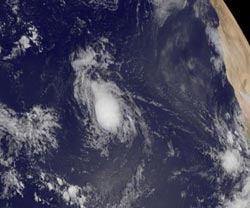NASA sees newborn Tropical Storm Joyce in the Central Atlantic

This visible image of Tropical Storm Joyce was captured by NOAA's GOES-13 satellite on Aug. 23 at 7:45 a.m. EDT. Credit: NASA GOES Project<br>
When NOAA's GOES-13 satellite captured an image of Tropical Depression 10 (TD10) on Aug. 23 at 7:45 a.m. EDT it appeared to have a well-rounded circulation. Infrared imagery indicated cold cloud top temperatures. Cold cloud top temperatures as cold as -63 Fahrenheit (-52 Celsius) show strength in the uplift of air that helps create strong thunderstorms that make up the tropical cyclone. The GOES-13 image was created using the NOAA satellite data at NASA's GOES Project, located at NASA's Goddard Space Flight Center in Greenbelt, Md.
On Aug. 23 at 11 a.m. EDT, Tropical Storm Joyce had maximum sustained winds near 40 mph (65 kmh). Joyce was located far from land, about 1,305 miles (2,105 km) east of the Leeward Islands near 15.2 North latitude and 42.2 West longitude. It was moving to the west-northwest near 17 mph (28 kmh).
Satellite data indicates that Joyce is dealing with a dry Saharan air layer, something that usually saps a tropical cyclone's warm, moist air. That dry air is wrapping around the southwestern part of Joyce's circulation.
The Saharan Air Layer is one thing that NASA is going to investigate in its upcoming Hurricane Severe Storm Sentinels (HS3) mission in September, using unmanned aircraft. For more information, go to: http://www.nasa.gov/HS3.
The National Hurricane Center noted that Joyce is following the southern edge of a subtropical ridge (elongated area) of high pressure over the Central Atlantic Ocean. Think of a marble rolling around the edge of a round clock. Once Joyce (the marble in this example) reaches the western edge, it will begin to turn to the northwest and then to the north.
Media Contact
More Information:
http://www.nasa.govAll latest news from the category: Earth Sciences
Earth Sciences (also referred to as Geosciences), which deals with basic issues surrounding our planet, plays a vital role in the area of energy and raw materials supply.
Earth Sciences comprises subjects such as geology, geography, geological informatics, paleontology, mineralogy, petrography, crystallography, geophysics, geodesy, glaciology, cartography, photogrammetry, meteorology and seismology, early-warning systems, earthquake research and polar research.
Newest articles

High-energy-density aqueous battery based on halogen multi-electron transfer
Traditional non-aqueous lithium-ion batteries have a high energy density, but their safety is compromised due to the flammable organic electrolytes they utilize. Aqueous batteries use water as the solvent for…

First-ever combined heart pump and pig kidney transplant
…gives new hope to patient with terminal illness. Surgeons at NYU Langone Health performed the first-ever combined mechanical heart pump and gene-edited pig kidney transplant surgery in a 54-year-old woman…

Biophysics: Testing how well biomarkers work
LMU researchers have developed a method to determine how reliably target proteins can be labeled using super-resolution fluorescence microscopy. Modern microscopy techniques make it possible to examine the inner workings…





















